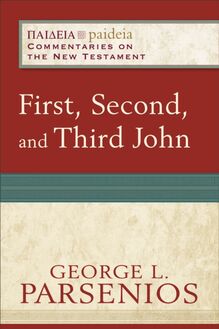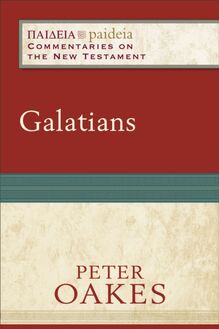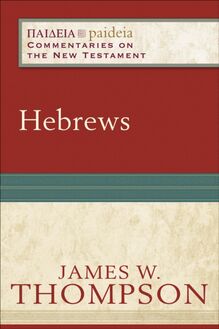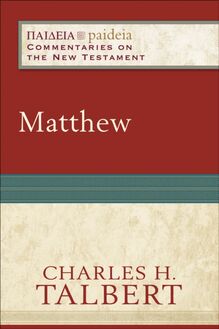-
 Univers
Univers
-
 Ebooks
Ebooks
-
 Livres audio
Livres audio
-
 Presse
Presse
-
 Podcasts
Podcasts
-
 BD
BD
-
 Documents
Documents
-
- Cours
- Révisions
- Ressources pédagogiques
- Sciences de l’éducation
- Manuels scolaires
- Langues
- Travaux de classe
- Annales de BEP
- Etudes supérieures
- Maternelle et primaire
- Fiches de lecture
- Orientation scolaire
- Méthodologie
- Corrigés de devoir
- Annales d’examens et concours
- Annales du bac
- Annales du brevet
- Rapports de stage
La lecture à portée de main
Vous pourrez modifier la taille du texte de cet ouvrage
Découvre YouScribe en t'inscrivant gratuitement
Je m'inscrisFirst and Second Peter (Paideia: Commentaries on the New Testament) , livre ebook
Découvre YouScribe en t'inscrivant gratuitement
Je m'inscrisEn savoir plus
Vous pourrez modifier la taille du texte de cet ouvrage
En savoir plus

Description
Sujets
Informations
| Publié par | Baker Publishing Group |
| Date de parution | 01 août 2012 |
| Nombre de lectures | 0 |
| EAN13 | 9781441238665 |
| Langue | English |
| Poids de l'ouvrage | 1 Mo |
Informations légales : prix de location à la page 0,0864€. Cette information est donnée uniquement à titre indicatif conformément à la législation en vigueur.
Extrait
First Peter © 2012 by Duane F. Watson
Second Peter © 2012 by Terrance Callan
Published by Baker Academic
a division of Baker Publishing Group
PO Box 6287, Grand Rapids, MI 49516-6287
www.bakeracademic.com
Ebook edition created 2012
All rights reserved. No part of this publication may be reproduced, stored in a retrieval system, or transmitted in any form or by any means for example, electronic, photocopy, recording without the prior written permission of the publisher. The only exception is brief quotations in printed reviews.
ISBN 978-1-4412-3866-5
Library of Congress Cataloging-in-Publication Data is on file at the Library of Congress, Washington, DC.
All quotations from 1 and 2 Peter are the authors’ own translations. Unless otherwise indicated, all other Scripture quotations are from the New Revised Standard Version of the Bible, copyright © 1989, by the Division of Christian Education of the National Council of the Churches of Christ in the United States of America. Used by permission. All rights reserved.
In honor and memory of Professor Cullen I. K. Story, of Princeton Theological Seminary, who instructed and inspired me to look carefully and reverently at sacred texts D. F. W.
For my students, whose questions have often shown me what I did not know T. C.
Contents
Cover
Series Page
Title Page
Copyright Page
Dedication
List of Figures ix
Foreword x
Preface to First Peter xii
Preface to Second Peter xiii
Abbreviations xiv
First Peter
Introduction to First Peter 3
Part 1: God’s Provision for Salvation, and Christians’ Status before God (1 Peter 1:1–2:10) 17
The Letter Prescript: Establishing Authority, Identity, and Goodwill (1 Peter 1:1–2) 19
Thanksgiving for God’s Gift of Salvation (1 Peter 1:3–12) 23
The Call and Motivation to Holiness (1 Peter 1:13–21) 31
Born Anew by the Word of God for Mutual Love (1 Peter 1:22–25) 38
Growing into Salvation (1 Peter 2:1–3) 42
Christ as the Living Stone, and Christians as the Spiritual House and God’s People (1 Peter 2:4–10) 46
Part 2: Living Honorably among the Gentiles (1 Peter 2:11–4:11) 55
Introduction to the Main Theme (1 Peter 2:11–12) 57
The Household Code (1 Peter 2:13–3:7) 62
Practicing Mutual Love and Peace with All (1 Peter 3:8–12) 80
Doing Good Rather than Evil amid Suffering, after Christ’s Example (1 Peter 3:13–22) 84
Living in the Spirit and Doing the Will of God (1 Peter 4:1–6) 95
The Need for Mutual Responsibility in Light of the End (1 Peter 4:7–11) 101
Part 3: Exhortations on Faithful Suffering among the Gentiles, and Conclusion (1 Peter 4:12–5:14) 107
Suffering Faithfully among the Gentiles (1 Peter 4:12–19) 109
Concluding Exhortations (1 Peter 5:1–11) 115
Epistolary Postscript (1 Peter 5:12–14) 124
Second Peter
Introduction to Second Peter 131
The Letter Opening (2 Peter 1:1–15) 147
The Letter Body (2 Peter 1:16–3:13) 167
Two Arguments against Opponents (2 Peter 1:16–2:10a) 168
Critique of Opponents (2 Peter 2:10b–22) 188
Occasion of the Letter Restated, and Argument against Opponents Resumed (2 Peter 3:1–13) 201
The Letter Closing (2 Peter 3:14–18) 213
Notes
Bibliography 221
Index of Subjects 234
Index of Modern Authors 238
Index of Scripture and Ancient Sources 241
Back Cover
Figures
Map of the Eastern Mediterranean Region 6 Temple of Concordia in Agrigento, Sicily 48 Bust of Emperor Nero 65 Roman Slaves 67 Crucifixion of Christ 71 Mosaic of a Roman Woman 73 An Ancient Prison 89 Mosaic of the God of Wine 97 Lion Statue 120 Map of the Roman World 130 East Terrace of Nemrud Dagh 135 Parallels between Jude and 2 Peter 141 Facsimile of 𝔓 72 146 Icon of Cyril of Jerusalem 164 Photograph of Remains near Qumran 207
Foreword
Paideia: Commentaries on the New Testament is a series that sets out to comment on the final form of the New Testament text in a way that pays due attention both to the cultural, literary, and theological settings in which the text took form and to the interests of the contemporary readers to whom the commentaries are addressed. This series is aimed squarely at students including MA students in religious and theological studies programs, seminarians, and upper-division undergraduates who have theological interests in the biblical text. Thus, the didactic aim of the series is to enable students to understand each book of the New Testament as a literary whole rooted in a particular ancient setting and related to its context within the New Testament.
The name “Paideia” (Greek for “education”) reflects (1) the instructional aim of the series giving contemporary students a basic grounding in academic New Testament studies by guiding their engagement with New Testament texts; (2) the fact that the New Testament texts as literary unities are shaped by the educational categories and ideas (rhetorical, narratological, etc.) of their ancient writers and readers; and (3) the pedagogical aims of the texts themselves their central aim being not simply to impart information but to form the theological convictions and moral habits of their readers.
Each commentary deals with the text in terms of larger rhetorical units; these are not verse-by-verse commentaries. This series thus stands within the stream of recent commentaries that attend to the final form of the text. Such reader-centered literary approaches are inherently more accessible to liberal arts students without extensive linguistic and historical-critical preparation than older exegetical approaches, but within the reader-centered world the sanest practitioners have paid careful attention to the extratext of the original readers, including not only these readers’ knowledge of the geography, history, and other contextual elements reflected in the text but also their ability to respond correctly to the literary and rhetorical conventions used in the text. Paideia commentaries pay deliberate attention to this extratextual repertoire in order to highlight the ways in which the text is designed to persuade and move its readers. Each rhetorical unit is explored from three angles: (1) introductory matters; (2) tracing the train of thought or narrative or rhetorical flow of the argument; and (3) theological issues raised by the text that are of interest to the contemporary Christian. Thus, the primary focus remains on the text and not its historical context or its interpretation in the secondary literature.
Our authors represent a variety of confessional points of view: Protestant, Catholic, and Orthodox. What they share, beyond being New Testament scholars of national and international repute, is a commitment to reading the biblical text as theological documents within their ancient contexts. Working within the broad parameters described here, each author brings his or her own considerable exegetical talents and deep theological commitments to the task of laying bare the interpretation of Scripture for the faith and practice of God’s people everywhere.
Mikeal C. Parsons Charles H. Talbert
Preface to First Peter
First Peter is a rich source of instruction, motivation, and hope for the Christian life. Its rich images and metaphors of the family and household of God, suffering resident foreigners, and people of covenant and priesthood, to name a few, enrich and inform our understanding of what it means to be a Christian. It is my hope that this commentary clearly conveys this epistle’s powerful message to its readers.
This commentary was nurtured during more than two decades of teaching the Hebrews and General Epistles class at Malone University. I want to thank my students for their interaction and the Malone Board of Trustees for granting the sabbatical leave that made the completion of this commentary possible.
I particularly want to thank Charles Talbert and Mikeal Parsons for inviting me to contribute to the Paideia series, and James Ernest and the editorial staff at Baker Academic for their careful reading and refinement of the manuscript.
I also want to thank my wife, Dr. JoAnn Ford Watson, for her continued love and support, and my daughter, Christina, who is beginning to ask hard questions of the biblical text.
The translation of 1 Peter is my own. All quotations from elsewhere in the Bible are from the NRSV. All quotations from Greek and Roman sources and the church fathers are from the Loeb Classical Library editions.
Duane F. Watson Malone University
Preface to Second Peter
I began intensive study of 2 Peter in 1997. In the spring quarter of that year, I had as usual described the relationship between Jude and 2 Peter as part of my course introducing the NT. The students in that course made me realize that my own understanding of the relationship between Jude and 2 Peter did not go very far, so I started to investigate the relationship more carefully. That began a period still not ended during which 2 Peter has been a major focus of my research and writing, as I have looked into more and more aspects of that very interesting text.
I am grateful to the Athenaeum of Ohio for two quasi-sabbaticals largely devoted to study of 2 Peter. I am grateful to the editors of Paideia for this opportunity to present some of what I have learned. And I am grateful for the way preparing this commentary has given me further opportunity to develop my understanding of 2 Peter.
I find 2 Peter a fascinating document and think it has more to say to the church than the church has yet heard. I hope this commentary helps bring readers into the world of 2 Peter more fully and increases their ability to understand its message. The commentary’s translation of 2 Peter is my own.
Terrance Callan The Athenaeum of Ohio
Abbreviations
General // indicates textual parallels AT author’s translation BCE before the Common Era ca. circa, approximately CE Common Era cf. compare contra in opposition to ed. edition, editor e.g. exempli gratia , for example esp. especially i.e. id est , that is lit. literally n note NT New Testam
-
 Univers
Univers
-
 Ebooks
Ebooks
-
 Livres audio
Livres audio
-
 Presse
Presse
-
 Podcasts
Podcasts
-
 BD
BD
-
 Documents
Documents
-
Jeunesse
-
Littérature
-
Ressources professionnelles
-
Santé et bien-être
-
Savoirs
-
Education
-
Loisirs et hobbies
-
Art, musique et cinéma
-
Actualité et débat de société
-
Jeunesse
-
Littérature
-
Ressources professionnelles
-
Santé et bien-être
-
Savoirs
-
Education
-
Loisirs et hobbies
-
Art, musique et cinéma
-
Actualité et débat de société
-
Actualités
-
Lifestyle
-
Presse jeunesse
-
Presse professionnelle
-
Pratique
-
Presse sportive
-
Presse internationale
-
Culture & Médias
-
Action et Aventures
-
Science-fiction et Fantasy
-
Société
-
Jeunesse
-
Littérature
-
Ressources professionnelles
-
Santé et bien-être
-
Savoirs
-
Education
-
Loisirs et hobbies
-
Art, musique et cinéma
-
Actualité et débat de société
- Cours
- Révisions
- Ressources pédagogiques
- Sciences de l’éducation
- Manuels scolaires
- Langues
- Travaux de classe
- Annales de BEP
- Etudes supérieures
- Maternelle et primaire
- Fiches de lecture
- Orientation scolaire
- Méthodologie
- Corrigés de devoir
- Annales d’examens et concours
- Annales du bac
- Annales du brevet
- Rapports de stage














